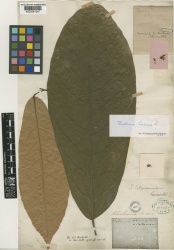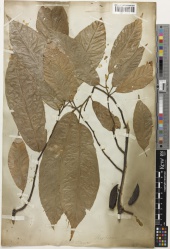| Plant: Handsome tree 9-12 M. (30-40°) high, round branches, bark gray, smooth; leaves 20-22.5 Cm. (8-9') long, 6 Cm. (2 2/5') side, lanceolate, acute, round base, entire, veins prominent beneath, petiole 2.5 Cm. (1') long, thickened at both ends; young leaves pink; flowers pale pink, calyx and corolla 2.5 Cm. (1') broad, alike in color.
Fruit: Large, 15-17.5 Cm. (6-7') long, broadly fusiform, with 10 shallow furrows and blunt ridges, tuberculated, pendulous, single or 2-3 together, at first yellow, then red, purple, pericarp thick, tough, 5-celled; seeds many, closely packed in tiers, size of almonds, angular from pressure, immersed in copious, sweet buttery pulp, seed-coats 2, brownish.
Source: Culbreth, D. (1917) A Manual of Materia Media and Pharmacology, 6th ed. [4]
|
|
|
|
| Theobroma Cacao Linn. is a handsome tree, from twelve to twenty feet in height, growing in Mexico, the West Indies, and South America. [...] The fruit is an oblong-ovate capsule or berry, six or eight inches in length, with a thick, coriaceous, somewhat ligneous rind, enclosing a whitish pulp, in which numerous seeds are embedded. These are ovate, somewhat compressed, about as large as an almond, and consist of an exterior thin shell and a brown oily kernel. Separated from the matter in which they are enveloped, they constitute the cacao, or chocolate nuts, of commerce.
Source: United States Dispensatory (1918) [5]
|
|
|
|
|



